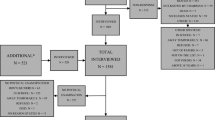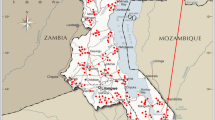Abstract
Surgery has become an integral part of global health care, with an estimated 234 million operations performed yearly. The World Bank in 2002 reported that an estimated 164 million disability-adjusted life years, representing 11% of the entire disease burden, were attributable to surgically treatable conditions. To study the prevalence of various surgical operations undergone by individuals in their life time, in an urbanized community of Delhi. Cross-sectional study, conducted from October 2008 to April 2009 in Vivek Vihar—an urban affluent colony in Delhi. A total of 3,043 individuals residing in 622 households were interviewed as part of the study. Total number of households with some member having ever undergone surgery was 306 (49.2%). 12.3% of our study population (375 out of 3,043) had undergone one or the other form of major surgical operation in their life time. Caesarean section was found to be the most common surgical procedure performed. 61.7% surgeries were elective in nature and 81.9% were performed in a private hospital. The lifetime prevalence of surgical procedures was 1.77% among children, 12.6% among adult males and 15.8% among adult females (p < 0.001). It was observed that the expense of surgeries conducted in private hospitals was more compared to government. Our findings suggest that surgery occurs at a substantial rate, at least among the urban affluent, with most of the patients choosing to refer to a private hospital for their surgery.
Similar content being viewed by others
References
Debas HT, Gosselin R, McCord C, Thind A. Surgery. In: Jamison DT, Breman JG, Measham AR, et al. (2006) Disease control priorities in developing countries. 2nd ed. Disease Control Priorities Project. Washington, DC: International Bank for Reconstruction and Development/World Bank: pp 1245–1260.
Weiser TG, Regenbogen SE, Thompson KD, Haynes AB, Lipsitz SR, Berry WR et al (2008) An estimation of the global volume of surgery: a modelling strategy based on available data. Lancet 372:139–144
Sreevidya S, Sathiyasekaran BW (2003) High caesarean rates in Madras (India): a population based cross-sectional study. BJOG 110:106–111
Bhasin SK, Rajoura OP, Sharma AK, Metha M, Gupta N, Kumar S, Joshi ID (2007) A high prevalence of caesarean section rate in East Delhi. Ind J Comm Med 32:222–224
American Heart Association. What is Coronary Bypass Surgery? Available at: http://www.americanheart.org/downloadable/heart/119626671501548%20WhatIsCornryBypsSrgry_9-07.pdf (Last accessed 05 October 2010)
Kumari S, Walia IJ, Singh AJ (2000) Self-reported uterine prolapse in a resettlement colony of north India. J Midwifery Womens Health 45:343–350
Singh AJ, Arora AK (2000) Menopausal women’s profile in rural north India—an integrated qualitative and quantitative study. Adv Obstet Gynecol 52:309–313
Singh AJ, Arora AK (2003) Effect of uterine prolapse on the lives of rural north Indian Women. Singapore J Obstet Gynecol 34:52–58
Singh AJ, Arora AK (2005) Profile of menopausal women in rural north India. Climacteric 8:177–184
Kennedy TM, Jones RH (2000) The epidemiology of hysterectomy and irritable bowel syndrome in a UK population. Int J Clin Pract 54(10):647–650
Settnes A, Jorgensen T (1996) Hysterectomy in a Danish cohort. Prevalence, incidence and socio-demographic characteristics. Acta Obstet Gynecol Scand 75(3):274–280
Ong S, Codd MB, Coughlan M, O'Herlihy C (2000) Prevalence of hysterectomy in Ireland. Int J Gynaecol Obstet 69(3):243–247
Schofield MJ, Hennrikus DJ, Redman S, Sanson-Fisher RW (1991) Prevalence and characteristics of women who have had a hysterectomy in a community survey. Aust N Z J Obstet Gynaecol 31(2):153–158
Sukwatana P, Meekhangwan J, Tamrongterakul T, Tanapat Y, Assavarit S, Boonjitrpimon P (1991) Menopausal symptoms among Thai women in Bangkok. Maturitas 13:217–218
Singh A, Arora AK (2008) Why hysterectomy rate are lower in India. Ind J Comm Med 33:196–197
Kennedy TM, Jones RH (2000) Epidemiology of cholecystectomy and irritable bowel syndrome in a UK population. Br J Surg 87:1658–1663
Conflicts of interest
None.
Funding /support source
None.
Author information
Authors and Affiliations
Corresponding author
Additional information
Guarantor: Dr Rupali Roy
Rights and permissions
About this article
Cite this article
Bhasin, S.K., Roy, R., Agrawal, S. et al. An Epidemiological Study of Major Surgical Procedures in an Urban Population of East Delhi. Indian J Surg 73, 131–135 (2011). https://doi.org/10.1007/s12262-010-0198-x
Received:
Accepted:
Published:
Issue Date:
DOI: https://doi.org/10.1007/s12262-010-0198-x




